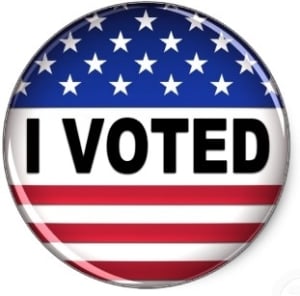I will always remember my first time voting; it was November 4, 2008, and I was finally old enough to vote! My best friend, Michelle, and I drove to our polling place. I had heard that there were machines that made it possible for a blind person to vote independently, so I asked the poll worker if I could use one. Her response was polite but disappointing: The machine was not working, and could my friend help me out?
Now that I’m older and somewhat wiser, I know that federal law requires that there be one working accessible voting machine at every polling place. I know that I could and should have asked for someone to try to get the machine to work. Failing that, I should have filed a complaint with my state’s board of elections. But I didn’t know any of this then, and luckily I trusted Michelle. We filled out our ballots, and off to class I went, proudly displaying my “I Voted” sticker for the world to see.
 My first experience voting independently did not happen until 2014. In the intervening years, I could not go to my polling place, and had to fill out an absentee ballot. It is impossible to put into words exactly how free I felt when I voted independently for the first time. 2014 was a completely different experience. I didn’t even have to ask for the accessible voting machine! The machine was set up, and I was left to my own devices, just like anyone else. No one else touched my ballot, and no one else could even see what I was doing as it is possible to black out the screen of the accessible voting machine. Total privacy and independence, exactly what voting should be!
My first experience voting independently did not happen until 2014. In the intervening years, I could not go to my polling place, and had to fill out an absentee ballot. It is impossible to put into words exactly how free I felt when I voted independently for the first time. 2014 was a completely different experience. I didn’t even have to ask for the accessible voting machine! The machine was set up, and I was left to my own devices, just like anyone else. No one else touched my ballot, and no one else could even see what I was doing as it is possible to black out the screen of the accessible voting machine. Total privacy and independence, exactly what voting should be!
It boggles my mind that before the Help America Vote Act in 2002, not voting independently was the norm for disabled Americans. I’ve heard stories of blind people having to go into the voting booth with three different people: one from each party and a third person to fill out the ballot. While we’ve come a long way from then, there is still work to do.
While accessible voting machines are required at polling locations, most states don’t have provisions for absentee voting. Absentee voting also needs to be accessible, and everyone—poll workers and citizens with disabilities—need to be aware of the right for everyone to vote independently. As this monumental election year progresses, it is imperative that we get out there and vote. Voting is a right we sometimes take for granted, but it is one that many have fought for, and it is the best way we have to create change.
Nallym Bravo works at National Braille Press (NBP) as a braille proofreader. NBP has produced braille voting materials for several states and hopes that more states provide accessible voting materials in the future.
